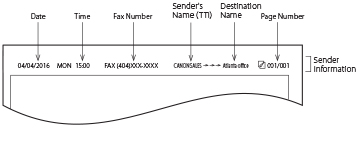Things You Must Do Before Using This Machine
This section describes the important setting registrations and procedures that must be done before the machine is used for sending operations.
IMPORTANT |
If you attempt to use the machine without registering the necessary information correctly, the machine may not function properly. The Remote Fax Kit is required to use the remote fax function. |
NOTE |
If this setting is incorrect, you will be unable to communicate with other machines. Be sure to check the type of telephone line that you are using, and make the correct setting. You can also register the type of telephone line for added fax lines. |
Remote Fax Settings
You can send faxes using the remote fax function and a server machine.
To use the machine as a remote fax client machine, you must set [Remote Fax TX Settings]. (See "Remote Fax TX Settings.")
To receive a fax on the client machine, you must specify the settings on the server machine to forward the received fax to the client machine as an I-fax. For more details on forwarding settings, see the instruction manuals of the server machine.
Setting the Display Language
To switch the display language, set [Switch Language/Keyboard On/Off] to 'On' before entering characters. (See "Enabling the Language/Keyboard Switch.")
If you switch [Switch Language/Keyboard On/Off] from 'Off' to 'On' after entering characters, the characters may not appear correctly. In this case, either re-enter the characters after setting [Switch Language/Keyboard On/Off] to 'On', or enter characters with [Switch Language/Keyboard On/Off] set to 'Off'.
If you set [Switch Language/Keyboard On/Off] to 'On', some characters are restricted and cannot be entered.
Registering the Sending Record
You can register a sender information which is printed on a recipient's side when you send a document by fax.
The registered information is printed as shown below. Depending upon the model of the machine at the receiving side, this information may also appear on the display while communication is taking place.

Date and Time
The date and time of the transmission are recorded.
Fax Number
The server machine's fax number is recorded.
Sender's Name (TTI (Transmit Terminal Identification))
The unit name of the server machine is recorded. If you register a name in [Sender Name (TTI)] on this machine, the sender name is recorded.
Destination Name
If you select a destination from the Address Book to send an original, the name of the stored destination appears on the sending record. (See "Storing New Addresses.")
Page Number
The current page number out of the total number of pages of the original is recorded.
Registering Sender Names
If you register a Sender Name, it appears on the recipient's machine or it is printed on sent documents, instead of the unit name. It is useful to register a department name and personal name. You can select the registered Sender Name when sending a fax. (See "Registering/Editing/Deleting Sender Names.")
Setting the Current Date and Time
You can set the current date and time. (See "Current Date and Time.")
The current date and time settings are used as standard timer settings for functions that require them.
<Time Zone>: | The standard time zones of the world are expressed globally in terms of the difference in hours (± up to 12 hours) from GMT*1 (± 0 hours). A time zone is a region throughout which this time difference is the same. |
<Daylight Saving Time>: | In some countries, time is temporarily advanced throughout the summer season. This practice is called "Daylight Saving Time." |
*1 The time at the Greenwich Observatory in England is called GMT (Greenwich Mean Time).
NOTE |
You can select the login user's name as the Sender Name if you are using the SSO-H login service. (The login name appears in <100> of Sender Names (TTI).) For more information on the SSO-H login service, see "SSO-H (Single Sign-On H)." To display/print the Sender Name instead of the unit name, set [Sender Name (TTI)] in Options. (See "Selecting the Sender's Name When Sending a Fax.") You can set this machine to adjust the date and time with the server on the network automatically. (See "Settings Common to TCP/IPv4 and TCP/IPv6.") |